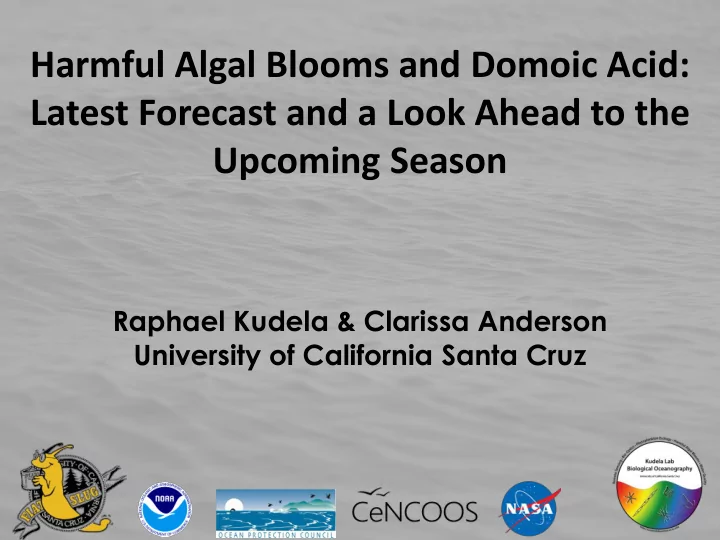

Harmful Algal Blooms and Domoic Acid: Latest Forecast and a Look Ahead to the Upcoming Season Raphael Kudela & Clarissa Anderson University of California Santa Cruz
Summary of 2016 • Transition to La Nina in 2016, return to climatologically normal • Pseudo-nitzschia & toxins started late (June), on track for a significant Autumn bloom • 2016 is very warm and toxic, but more spatially variable — the late development of the bloom could result in trophic transfer to the benthic environment similar to 2015 • Toxicity may have peaked in September
Global Temperature Anomaly
Monterey Bay Temperatures
2016 is Warm & Toxic A warmer Eastern Santa Cruz Wharf Total Domoic Acid Pacific with localized upwelling would (statistically) increase the chance of more large-scale bloom events in the future
2016 Predicted Domoic Acid JULY AUGUST SEPTEMBER http://www.cencoos.org/data/models/habs PDA Probability
PDA Model Tracks Crab Toxicity Santa Barbara Block 710, CDFW Crab DA Model Threshold 20 ppm The Water-column model leads crab toxicity by about one month
Trinidad Model Probability (pDA>500 ng/L) Crab/Shellfish DA (ppm) Monterey Santa Barbara Red=Crab, Yellow=Mussel Crab Data from: http://www.cdph.ca.gov/healthinfo/pages/fdbdomoicacidinfo.aspx
pDA Probability October 3-5 Probability of Domoic Acid > 500 ng/L Change in Probability, September to October
Current Status • Observations and models suggest patchy, high-toxin regions that could accumulate (locally) in crabs and other organisms but not as widespread as 2015 • Seasonal decrease in bloom activity started at end of October (good news!) • Models and limited observations suggest that the bloom has been pushed offshore. This and the “warm blob” in the Pacific Northwest are similar to conditions prior to 2015, suggesting 2017 has the potential to be another bloom year if this persists through the winter, but is highly dependent on winter/spring conditions
Improving Predictive Capability New Saltonstall-Kennedy (NOAA) funded project to add continuous plankton monitoring offshore
Thank You Raphael Kudela University of California Santa Cruz kudela@ucsc.edu 831-459-3290
Recommend
More recommend